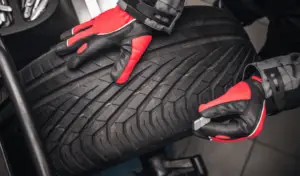As you’re well aware, winter are more expensive than all-season tires but perform so much better at lower temperatures.
In this post, we’ll examine the speed you should travel in different weather conditions when using winter tires.
Winter tires have speed ratings, but these are not aligned with the maximum speed recommended with snow or ice on the road. They are the maximum speed the tires are designed for in normal driving conditions.
Where all seasons struggle to grip these tires with their softer compounds take compacted snow in their stride. They achieve this by staying supple at lower temperatures where all season’s compounds stiffen.
However, they can give drivers a false sense of safety and result in some driving at speeds the tires can’t grip.
Let’s look at this in more detail
Compact Snow Maximum Speed
Winter tires are designed to be used in snow. When fitted, winter tires can allow you to drive at much faster speeds than normal in poor weather.
There is no maximum speed listed by tire manufacturers, only an overall speed rating. They argue that all weather conditions are slightly different, as are the road conditions, and speed should vary accordingly.
Therefore the ultimate decision on what speed to drive must take into account these issues, and it’s not a decision they can make.
People also read: How Fast Can You Go With Chains on Your Tires?
Compact Snow Braking Distances
This question isn’t asked as much as the maximum speed question, but the results compared to summer tires are genuinely eye-opening.
A test comparing winter and all-season tires of the same brand on the same make of car at 30 mph found that summer tires took three times the distance to stop, and the car with them fitted was still traveling at 25 mph as it passed the car that has already stopped that was fitted with winter tires.
Summer tires had only lost five mph by the time that winter tires had brought that car to a complete stop.
Here is the video of the test this channel did comparing winter and all-season tires
People also read: How Fast Can You Go With Studded Tires
No Snow Maximum Speed
Some people think winter tires can’t be driven at speed in ideal conditions, but this isn’t the case. Winter tires are rated to be driven more than 100 mph, where legal to do so.
The lowest speed rating is Q, and this speed category is up to 160 km/h or 99 mph and rises to rate V, which is good for 240 km/h or 161 mph.

No Snow Braking Distances
This is interesting. The same channel that performed the comparison test between winter and all-season tires on snow also did a brake test in colder temperatures on wet roads.
Most people don’t consider the benefits of winter tires in non-snow conditions. Still, the results showed at below 7 celsius or 45 Fahrenheit on a wet road; the winter tire was considerably quicker at stopping the car.
The takeaway from this is if you can afford the additional expense of winter tires, there may be safety benefits if the weather is still quite cold and wet in your locality.
Ice Maximum Speed
Ice is compacted snow, so the same caveats apply to the guidance given. There is no golden speed that a car is safe to be driven at, only the same one that tire manufacturers state. And that is to drive in line with the road and weather conditions.
That being said, you’ll be able to drive faster than a car with all seasons because of the extra grip. How fast a driver decides to take that advantage will always be up to them.
Ice Braking Distances
Please refer to the compacted snow answer above, as ice and compacted snow are very similar.
Can I Use Winter Tires In My State?
Good question!
During periods of expected severe weather, a state may advise that winter tires should be used, but this isn’t the law.
In Canada, though, things are a bit different. Quebec, for instance, has mandatory winter tire regulations between December and March.
Other Canadian regions haven’t gone this far. A recent government review in Ontario recognized the benefits but didn’t want to force road users to buy them and gave them the freedom to choose instead.
How Long Do Winter Tires Last?
Three factors will dictate how long your winter tires last
An average pair of winter tires should last roughly as long as a standard pair of summer tires when used as intended in colder climates. The softer rubber of winter tires, which aren’t made for warmer climates, will soon wear out if you leave them on your car all year.
- How often do you use them – I know it’s obvious. Winter tires should last the same length of time as all-season tires.
- If they are used in summer, the rubber compound they are made of is unsuitable for the hotter weather, and the heat generated can’t be dispersed. Many times they’ll need replacing come the fall.
- All tires regularly driven on gravel roads will wear quicker than those driven on paved roads. Winter tires are no different. The more miles driven off paved roads increase the chances of hitting a pothole or getting punctured by a sharp piece of loose gravel.
How Often Should I Check My Winter Tires?
Winter tires, if driven at the right time of the year, don’t need special treatment compared to all seasons.
Every week walk around your car and inspect the tire for any sharp tacks or nails or sharp gravel and remove them. Check the tire wall isn’t scuffed near the tread, as this indicates low tire pressure.

Finally, get a gauge and check the tire pressure. Each tire manufacturer will stipulate what PSI is needed. Generally, winter tires need a higher pressure the colder the weather, and a 1 PSI increase for every 10 degrees Fahrenheit reduction in temperature is often cited.
Do You Need Winter Tires On All 4 Tires?
It may be tempting to put winter tires on the wheel, providing the drive, and leave all seasons on the other two. Don’t be tempted, though.
Doing this will mean one-half of your car will perform better than the other. This won’t be as noticeable when driving straight in dry conditions, but your car can behave erratically if you need to brake or turn sharply in rain or snow.
What’s The Difference Between Winter and Studded Tires?
Studded tires outperform winter tires in compacted snow and ice as they give better traction.
Winter tires work better in the cold, wet, and slush and are always preferable in the winter to all seasons tires.
A downside of studded tires is they are more expensive, aren’t always allowed on highways in certain states, and will have to be changed to all seasons as soon as the snow retreats in the spring.
In Conclusion
Most winter tires have speed ratings of 100 mph and higher. However, driving on snow is the primary function of winter tires. Generally, you shouldn’t go over 40 mph while driving in these circumstances. A breaking-in period is also important for winter tires.


![How Fast Can You Go With Studded Tires? [Answered] stud-tires](https://carzaza.com/wp-content/uploads/2023/12/stud-tires-300x150.png)
![How Fast Can You Go With Chains on Your Tires? [Answered] snow-chain-frozen](https://carzaza.com/wp-content/uploads/2023/12/snow-chain-frozen-300x150.png)









